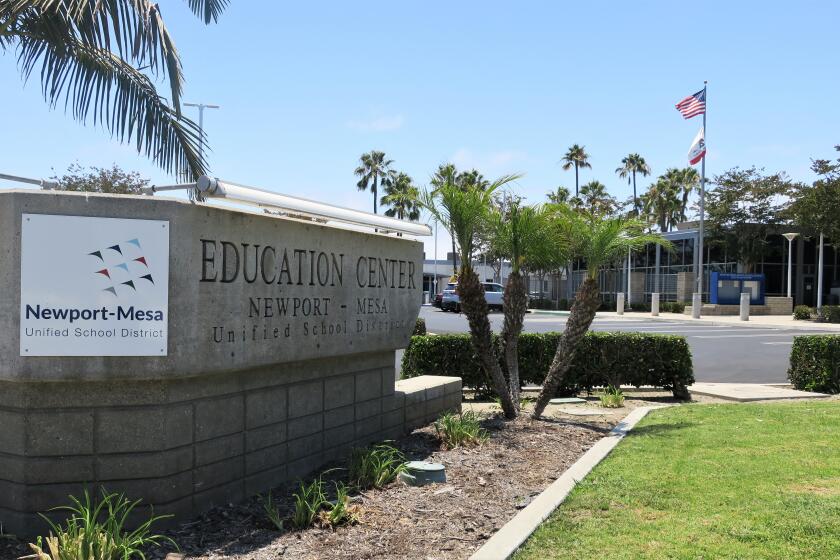Costa Mesa forecasts millions in medical marijuana tax revenue — and budget deficits
Medical marijuana businesses are expected to bring a lot of green to Costa Mesa, potentially including millions of tax dollars flowing into city coffers each year, according to figures discussed Tuesday.
Despite that, the city forecasts that total expenses will increase faster than revenue, leading to budget deficits, officials said.
According to the city’s most recent five-year financial plan, Costa Mesa anticipates receiving about $1.56 million in tax revenue from marijuana-related businesses in the next fiscal year.
That money would grow annually, reaching an estimated $6 million in fiscal 2022-23, the forecast shows.
Under Measure X — approved by local voters in 2016 — businesses that research, test, process and manufacture some medical marijuana products are allowed to open in a specified area north of South Coast Drive and west of Harbor Boulevard. Those businesses are subject to a 6% tax on annual gross receipts.
This week, the city Planning Commission reviewed applications for five medical marijuana manufacturing and distribution facilities and approved permits for three of them while delaying action on two. That’s on top of two others the commission previously approved.
Given the revenue potential, City Manager Tom Hatch floated the idea of devoting a portion of the collected tax to help pay down the city’s unfunded pension liability, most recently pegged at about $270 million.
“It’s not often we get a new revenue source [like] the marijuana business tax and it’s not often that it is that significant of a potential new revenue source,” Hatch told the City Council during Tuesday’s study session.
Councilman Jim Righeimer, however, said he’s opposed to such an earmark.
“‘Gosh, [I] hope the pension works out and more people get stoned,’” he said. “I mean, it’s not a good way to think.”
Mayor Pro Tem Allan Mansoor urged caution regarding any medical marijuana-related windfall, saying other cities could line up to compete with Costa Mesa for such businesses.
“I’d rather have a surprise on the plus side than a surprise on the negative side,” he said.
The five-year financial plan — which Hatch described as “a conservative approach at projecting long-term issues that the City Council and the community will wrestle with” — forecasts a budget deficit of $3.9 million next fiscal year.
That figure would increase annually, eventually hitting $8.2 million in 2022-23, projections show.
“Basically, unless something happens, we’re going to have to rein in our spending,” Mayor Sandy Genis said. “I mean, unless we magically have money fall out of the sky.”
Hatch said city staff is committed to bringing the council balanced spending plans each year. Possible strategies to balance the books could include finding ways to reduce costs for lower-priority items, updating city fees to better recover costs or repurposing money currently devoted to capital projects, according to a staff report.
One idea endorsed by the city Finance & Pension Advisory Committee is raising the transient occupancy tax charged for motel and hotel stays. The city’s rate for that tax is currently 8%, but the committee has recommended boosting it to 10%, saying that’s in line with other Orange County cities.
Councilwoman Katrina Foley questioned whether the five-year financial plan fully reflects the increased fees the city expects to receive from the new ambulance transportation services model approved last year.
Foley also said she’d like to see staff develop different budgetary options for the council to review.
“With the revenues that we’re projecting, we’ve still got to figure out a solution,” she said. “So unless we’ve got some mechanism to kind of look at different scenarios — if this, then that — I don’t see how we can, as a body, give direction on what we want to prioritize.”
Councilman John Stephens noted that the city has been doing budget forecasts for years and said he’d like additional analysis to “test whether or not the methodology that’s used” has been accurate.
“I don’t want to understate or overstate the concern here,” he said. “I just want to have some statistical guideline to be able to give this analysis whatever weight it’s entitled to.”
Twitter @LukeMMoney
All the latest on Orange County from Orange County.
Get our free TimesOC newsletter.
You may occasionally receive promotional content from the Daily Pilot.




